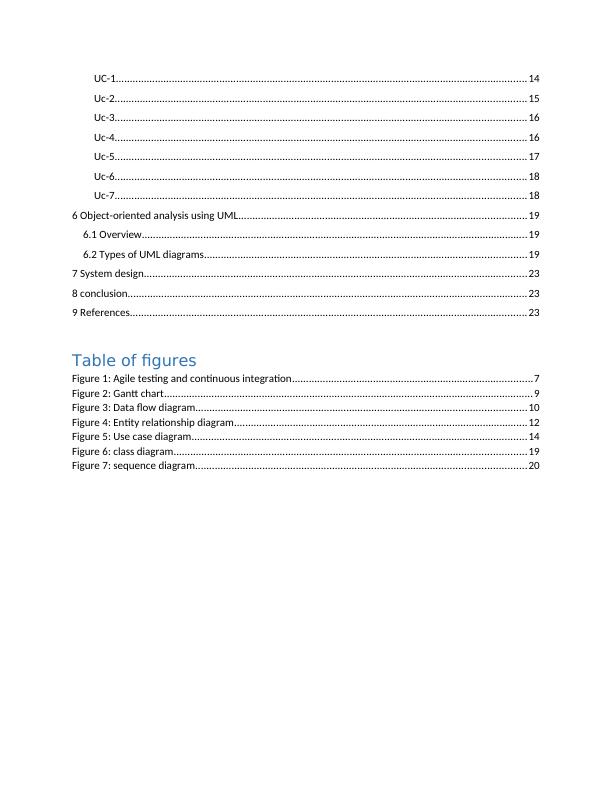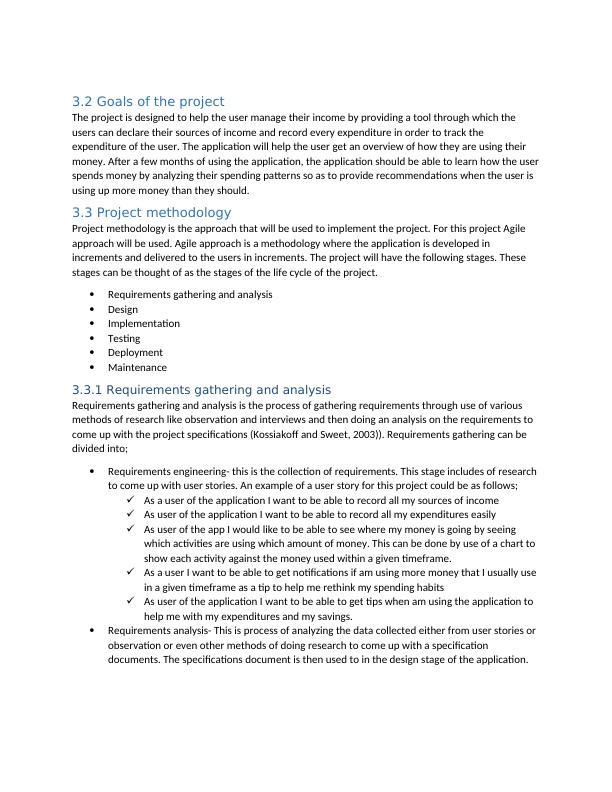Ask a question from expert
MGMT 4870 - Document On Problem Statement and Feasibility Study|
25 Pages5166 Words209 Views
Kenyatta University
Agile Modelling and Prototyping (MGMT 4870)
Added on 2020-03-04
About This Document
This document discusses the design and implementation of a spending application that will help its users to track usage of their incomes to facilitate better spending habits and money-saving habits. The document discusses the problem statement as well as presents a feasibility study report to show and justify whether the project is feasible or not.
MGMT 4870 - Document On Problem Statement and Feasibility Study|
Kenyatta University
Agile Modelling and Prototyping (MGMT 4870)
Added on 2020-03-04
BookmarkShareRelated Documents
8/20/2017Student NameSTUDENTIDAgile Modellingand PrototypingExpenditure Tracking Application

ContentsTable of figures............................................................................................................................................21 Introduction..............................................................................................................................................42 problem statement...................................................................................................................................43 Scope of the project.................................................................................................................................43.1 Project objectives..............................................................................................................................43.2 Goals of the project...........................................................................................................................53.3 Project methodology.........................................................................................................................53.3.1 Requirements gathering and analysis.........................................................................................53.3.2 Design.........................................................................................................................................63.3.3 Implementation..........................................................................................................................63.3.4 Testing........................................................................................................................................63.3.5 Deployment................................................................................................................................73.3.6 Maintenance...............................................................................................................................83.4 Resources required............................................................................................................................83.5 Budget...............................................................................................................................................83.6 schedule............................................................................................................................................84 Feasibility study and report......................................................................................................................94 Functional requirements..........................................................................................................................94.1 Functional process requirements......................................................................................................94.2 Data requirements...........................................................................................................................114.2.1 Entity relationship diagram.......................................................................................................114.2.2 Entity definitions.......................................................................................................................124.2.3 Data dictionary.........................................................................................................................124.2 Operational requirements...............................................................................................................124.2.1 Security.....................................................................................................................................134.2.2 Data currency...........................................................................................................................134.2.3 Reliability..................................................................................................................................134.2.4 System availability....................................................................................................................134.2.3 Performance.............................................................................................................................135 Use case modelling.................................................................................................................................135.1 use case description........................................................................................................................14

UC-1...................................................................................................................................................14Uc-2...................................................................................................................................................15Uc-3...................................................................................................................................................16Uc-4...................................................................................................................................................16Uc-5...................................................................................................................................................17Uc-6...................................................................................................................................................18Uc-7...................................................................................................................................................186 Object-oriented analysis using UML.......................................................................................................196.1 Overview..........................................................................................................................................196.2 Types of UML diagrams...................................................................................................................197 System design.........................................................................................................................................238 conclusion...............................................................................................................................................239 References..............................................................................................................................................23Table of figuresFigure 1: Agile testing and continuous integration......................................................................................7Figure 2: Gantt chart....................................................................................................................................9Figure 3: Data flow diagram......................................................................................................................10Figure 4: Entity relationship diagram.........................................................................................................12Figure 5: Use case diagram........................................................................................................................14Figure 6: class diagram..............................................................................................................................19Figure 7: sequence diagram......................................................................................................................20


1 IntroductionThis document discusses the design and implementation of a spending application which will help its users to track usages of their incomes to facilitate better spending habits and money saving habits. The document discusses the problem statement as well as presenting a feasibility study report to show and justify whether the project is feasible or not. The document also shows different models of the system which can be used to give both a conceptual and in depth view of the proposed application and at the final stages it discusses the possible design for the proposed application including the factors to considerwhile designing the application.2 problem statementIn the current times, many people do not keep track of their expenditures and income. This can be attributed to the fact that income is not as often as expenditures thus many people get an income for example every month but the expenditures that go in between the month from the day the person is paid until the time they get the next income are very many. Expenditures happen almost every moment of our life ranging from the smallest expenditures that require very little money to big expenditures that require a large amount of money. Due to lack of a tracking tool which people can use to track their expenditures people end up not knowing where their income is going except for the big projects which are easy to remember. When a person is not tracking their expenditures, it’s very hard for that person tosave money and they end up using more money than they should use as a result of impulse buying and adapting spendthrift behaviors. An expenditure tracking application can help people who have a problem with spending money get an insight on where most of their money is going thus help them to adapt better spending behaviors and in the long run help the users to save some of their income.3 Scope of the project3.1 Project objectivesThe following will be the objectives of the project;Provide users with an interface when they can declare their source of incomes and what each source is generating within a given timeframe. This sources of income will automatically add the declared amount of income after every timeframe is reached.Provide users with an interface where they can add unofficial sources of income; for example money earned by the user and was not planned for.Provide users with an interface where they can add expenditures in a very easy way as expenditures are very frequent.Provide the users with an overview of how he or she is using their money. This can be a graph showing income against expenditure.Give users tips on how to save their money.Study user spending habits then use this data to predict if the user is overspending money thus generate a notification warning the user thus that they are going over their normal spending rates in a given timeframe. For example if a user spends approximately Show reports to the user of where most of the money is going to thus giving them a chart showing which activities are using up more money and which activities are using the least money.

3.2 Goals of the projectThe project is designed to help the user manage their income by providing a tool through which the users can declare their sources of income and record every expenditure in order to track the expenditure of the user. The application will help the user get an overview of how they are using their money. After a few months of using the application, the application should be able to learn how the userspends money by analyzing their spending patterns so as to provide recommendations when the user is using up more money than they should.3.3 Project methodologyProject methodology is the approach that will be used to implement the project. For this project Agile approach will be used. Agile approach is a methodology where the application is developed in increments and delivered to the users in increments. The project will have the following stages. These stages can be thought of as the stages of the life cycle of the project.Requirements gathering and analysisDesignImplementationTestingDeploymentMaintenance3.3.1 Requirements gathering and analysisRequirements gathering and analysis is the process of gathering requirements through use of various methods of research like observation and interviews and then doing an analysis on the requirements to come up with the project specifications (Kossiakoff and Sweet, 2003)). Requirements gathering can be divided into;Requirements engineering- this is the collection of requirements. This stage includes of researchto come up with user stories. An example of a user story for this project could be as follows;As a user of the application I want to be able to record all my sources of incomeAs user of the application I want to be able to record all my expenditures easilyAs user of the app I would like to be able to see where my money is going by seeing which activities are using which amount of money. This can be done by use of a chart to show each activity against the money used within a given timeframe.As a user I want to be able to get notifications if am using more money that I usually use in a given timeframe as a tip to help me rethink my spending habitsAs user of the application I want to be able to get tips when am using the application to help me with my expenditures and my savings.Requirements analysis- This is process of analyzing the data collected either from user stories or observation or even other methods of doing research to come up with a specification documents. The specifications document is then used to in the design stage of the application.

End of preview
Want to access all the pages? Upload your documents or become a member.
Related Documents
System Development Life Cycle (SDLC) - A Surveylg...
|47
|18551
|217
Website Investigation and Analysis - Deskliblg...
|17
|1805
|50
Bus Ticket Booking Website - Product Backlog, UML Profile, Sprint Planninglg...
|25
|1509
|411
Unit 20: Advanced Programming Assignmentlg...
|28
|4015
|256
System Analysis & Design : Software Development Life Cyclelg...
|46
|10454
|242
Development of an Automated Solution for Su Ying's Noodle Barlg...
|12
|2569
|56